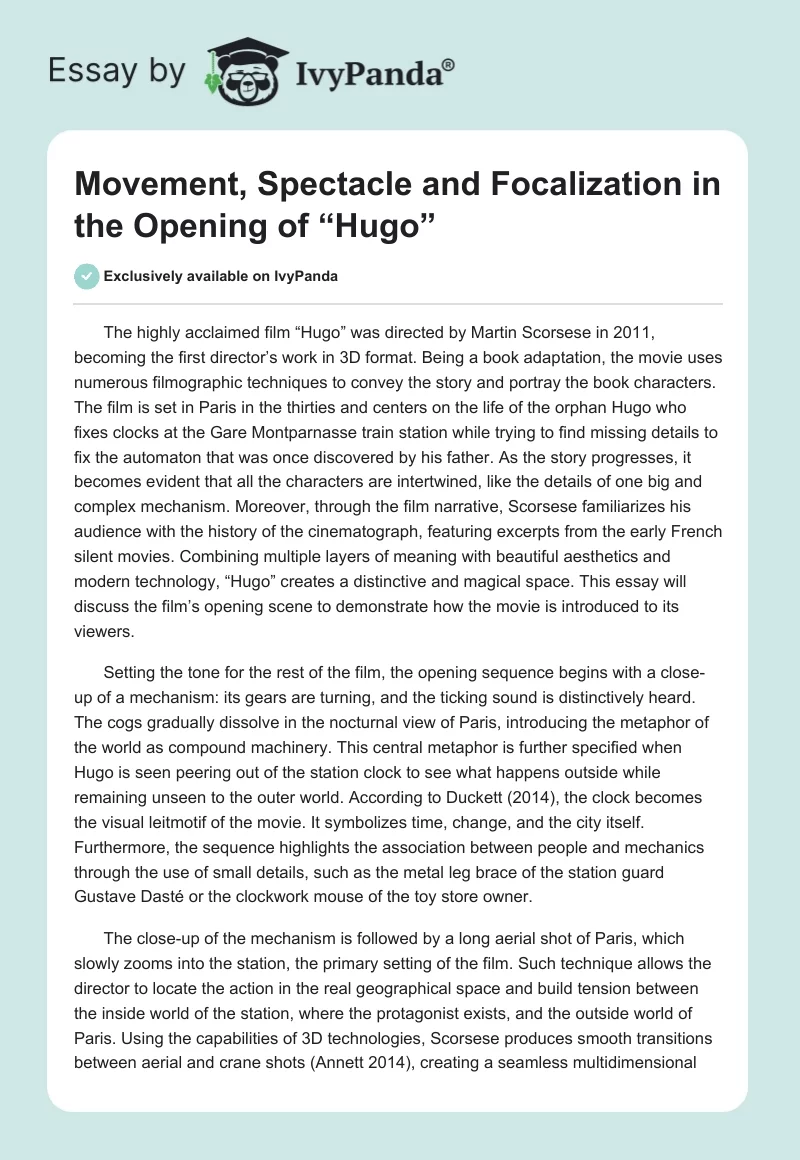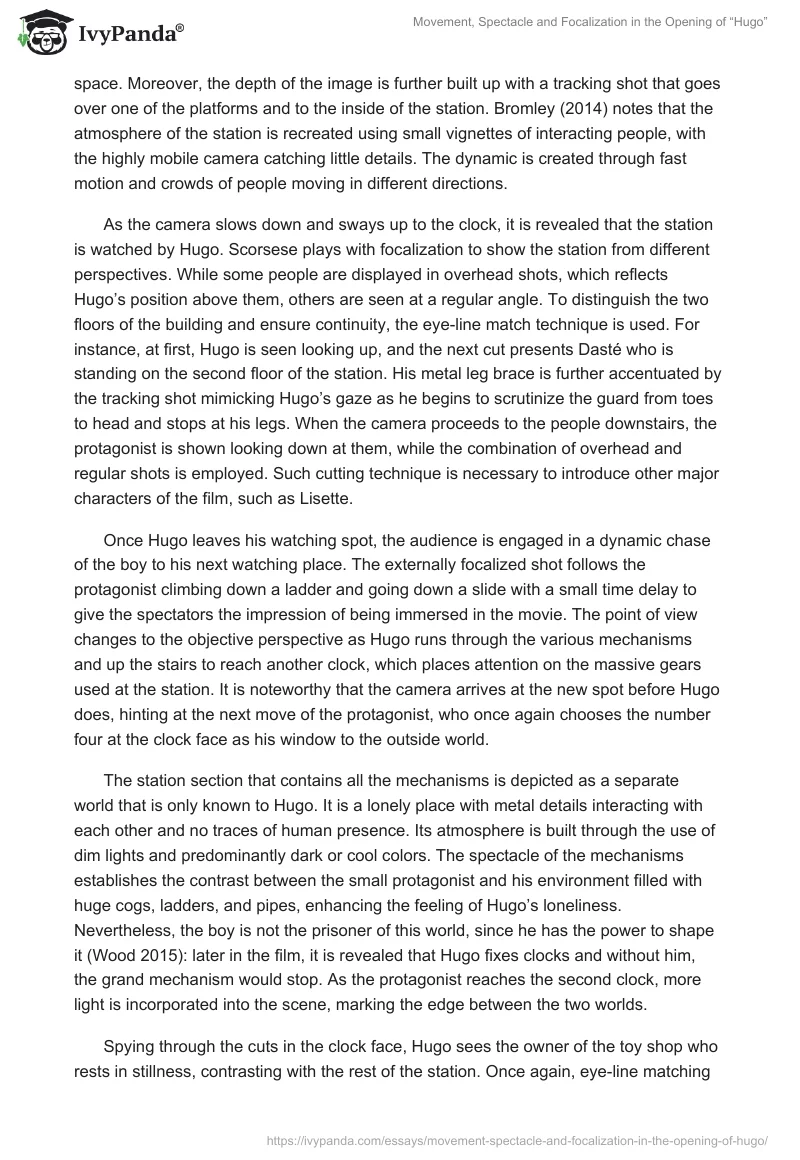The highly acclaimed film “Hugo” was directed by Martin Scorsese in 2011, becoming the first director’s work in 3D format. Being a book adaptation, the movie uses numerous filmographic techniques to convey the story and portray the book characters. The film is set in Paris in the thirties and centers on the life of the orphan Hugo who fixes clocks at the Gare Montparnasse train station while trying to find missing details to fix the automaton that was once discovered by his father. As the story progresses, it becomes evident that all the characters are intertwined, like the details of one big and complex mechanism. Moreover, through the film narrative, Scorsese familiarizes his audience with the history of the cinematograph, featuring excerpts from the early French silent movies. Combining multiple layers of meaning with beautiful aesthetics and modern technology, “Hugo” creates a distinctive and magical space. This essay will discuss the film’s opening scene to demonstrate how the movie is introduced to its viewers.
Setting the tone for the rest of the film, the opening sequence begins with a close-up of a mechanism: its gears are turning, and the ticking sound is distinctively heard. The cogs gradually dissolve in the nocturnal view of Paris, introducing the metaphor of the world as compound machinery. This central metaphor is further specified when Hugo is seen peering out of the station clock to see what happens outside while remaining unseen to the outer world. According to Duckett (2014), the clock becomes the visual leitmotif of the movie. It symbolizes time, change, and the city itself. Furthermore, the sequence highlights the association between people and mechanics through the use of small details, such as the metal leg brace of the station guard Gustave Dasté or the clockwork mouse of the toy store owner.
The close-up of the mechanism is followed by a long aerial shot of Paris, which slowly zooms into the station, the primary setting of the film. Such technique allows the director to locate the action in the real geographical space and build tension between the inside world of the station, where the protagonist exists, and the outside world of Paris. Using the capabilities of 3D technologies, Scorsese produces smooth transitions between aerial and crane shots (Annett 2014), creating a seamless multidimensional space. Moreover, the depth of the image is further built up with a tracking shot that goes over one of the platforms and to the inside of the station. Bromley (2014) notes that the atmosphere of the station is recreated using small vignettes of interacting people, with the highly mobile camera catching little details. The dynamic is created through fast motion and crowds of people moving in different directions.
As the camera slows down and sways up to the clock, it is revealed that the station is watched by Hugo. Scorsese plays with focalization to show the station from different perspectives. While some people are displayed in overhead shots, which reflects Hugo’s position above them, others are seen at a regular angle. To distinguish the two floors of the building and ensure continuity, the eye-line match technique is used. For instance, at first, Hugo is seen looking up, and the next cut presents Dasté who is standing on the second floor of the station. His metal leg brace is further accentuated by the tracking shot mimicking Hugo’s gaze as he begins to scrutinize the guard from toes to head and stops at his legs. When the camera proceeds to the people downstairs, the protagonist is shown looking down at them, while the combination of overhead and regular shots is employed. Such cutting technique is necessary to introduce other major characters of the film, such as Lisette.
Once Hugo leaves his watching spot, the audience is engaged in a dynamic chase of the boy to his next watching place. The externally focalized shot follows the protagonist climbing down a ladder and going down a slide with a small time delay to give the spectators the impression of being immersed in the movie. The point of view changes to the objective perspective as Hugo runs through the various mechanisms and up the stairs to reach another clock, which places attention on the massive gears used at the station. It is noteworthy that the camera arrives at the new spot before Hugo does, hinting at the next move of the protagonist, who once again chooses the number four at the clock face as his window to the outside world.
The station section that contains all the mechanisms is depicted as a separate world that is only known to Hugo. It is a lonely place with metal details interacting with each other and no traces of human presence. Its atmosphere is built through the use of dim lights and predominantly dark or cool colors. The spectacle of the mechanisms establishes the contrast between the small protagonist and his environment filled with huge cogs, ladders, and pipes, enhancing the feeling of Hugo’s loneliness. Nevertheless, the boy is not the prisoner of this world, since he has the power to shape it (Wood 2015): later in the film, it is revealed that Hugo fixes clocks and without him, the grand mechanism would stop. As the protagonist reaches the second clock, more light is incorporated into the scene, marking the edge between the two worlds.
Spying through the cuts in the clock face, Hugo sees the owner of the toy shop who rests in stillness, contrasting with the rest of the station. Once again, eye-line matching is applied to introduce Hugo’s perspective. Furthermore, this technique reveals to the audience that the owner George knows about Hugo’s presence. The owner uses the clockwork mouse to lure Hugo: the internally focalized shot demonstrates how the boy fixates his gaze on the toy, which is the only moving object in the shop. The scene proceeds to introduce Isabelle, who stops for a short chat with Georges and is being watched by Hugo. Once the owner appears to be asleep, the new close-up shot of the mouse reveals the boy’s desire for it (North 2014). After the protagonist comes out of his hiding to steal the toy, the focalized tracking shot is employed to create suspense as Hugo slowly approaches his goal. The scene culminates in George’s abrupt move to catch the boy and his first heard phrase — “caught you at last” (Hugo opening 2013).
The film opening sequence simultaneously serves several goals. First of all, it introduces the setting of the story and its main characters. Secondly, the sequence establishes the movie’s atmosphere and leitmotivs. Thirdly, the film’s narration engages the audience by creating the mystery surrounding Hugo. The techniques reviewed in this essay allow Scorsese to offer the spectators an invitation they cannot resist — the invitation to solve the enigma of Hugo Cabret.
Reference List
Annett, S 2014, ‘The nostalgic remediation of cinema in Hugo and Paprika’, Journal of Adaptation in Film & Performance, vol. 7, no. 2, pp. 169-180.
Bromley, CM 2014, Brave new forms: adaptation, remediation, and intertextuality in the multimodal world of Hugo Cabret, Master’s Thesis, Eastern Michigan University, Web.
Duckett, V 2014, ‘Unwinding the film spool: Hugo, Méliès, and our return to early film, Studies in Documentary Film, vol. 8, no. 1, pp. 33-42.
Hugo opening 2013, online video, YouTube, 2018, Web.
North, D 2014, ‘Nurturing young cinephiles: Martin Scorsese’s Hugo’, in Karin Beeler & Stan Beeler (eds.), Children’s film in the digital age: essays on audience, adaptation and consumer culture, McFarland & Company, Jefferson, NC, pp. 98-108.
Wood, 2015, ‘Intangible spaces: three-dimensional technology in Hugo and IMAX in The Dark Knight’, Convergence, vol. 21, no. 2, pp. 169-181


